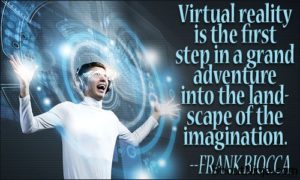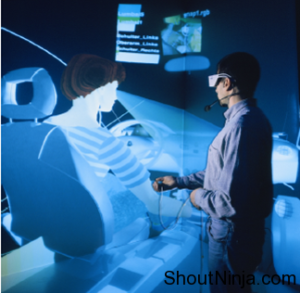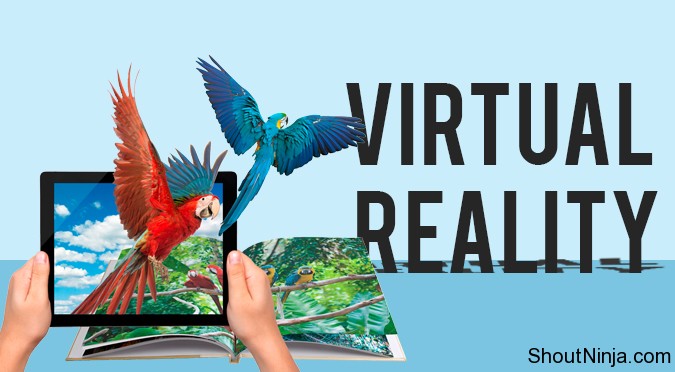Have you ever been to mars ? Drive Audi on moon ? Swim along-with Sharks ? Playing Euro soccer cup with Messi ? or Moving on top of mountains with your Dreamgirl ?
Seems impossible but Virtual reality (VR) can help you do all these things easily.
Virtual reality (VR) means making the things which are virtual (may not real), a reality with the help of computers. Virtual reality devices like Head mounted displays (HMDs) helps you to sense the things (like driving bike in clouds) both mentally & physically which might be difficult or not possible in real world. It is an artificial visual environment which immerses the viewer into this virtual world by wearing specialized devices such as HMDs (or smartphone).
According to Wikipedia, Virtual realities artificially create sensory experience, which can include sight, touch, hearing, and smell.
With VR technology, anything can become reality whatever you can imagine.

virtual reality imagination
Now, it may make sense to understand how the use of Virtual reality can enhance our gaming experience where you are sitting in Formula car driver seat & having a race with top car racer. You can sense how its use in movies can make us feel real. But applications of Virtual reality (VR) is not limited to just entertainment. It has wide exposure in different domains like education, tourism, medical treatment, Arts, etc.
How Virtual Reality works today:
Virtual / Artificial world is created through software, just like a video game. You wear VR technology enabled device like Oculus rift which consist of headphones & Googles. After that some Computer or 360 degree camera is used to provide you the imagery. There exist some special motion sensors in you Googles (or HMDs) which detect motion of your head and the image in software changes accordingly so you feel like you are in real world.
Bigger companies has already started to work in VR & Facebook bought Oculus VR for $2 billion.
Founder of Oculus VR, Palmer Luckey said:
“Most people don’t have computers with high-end graphics cards. In the future, that’s going to change: give it five or six years, and most computers will be capable of running good virtual experiences.”
Some of the applications of VR include:
Retail:
It can be widely used in retail by which you can get a look & feel of any thing by comfort of your home. e.g. IKEA have developed systems that allow its products to be seen in virtual reality, to give consumers a better idea of how the product will fit into their home.
Defense training:
Now, defense corps can use VR enabled technology to enter into the simulated world where they will be able to see the enemy’s team firing on them. Consider, Army people practice how to fight when terrorists attack by experience through VR. They can able to sense different threats which they otherwise face while actual fight.

virtual reality application
Healthcare:
Medical training can get a lot of help via VR like in case of surgery. Simulators is one of the many examples where hospitals pays a lot of money to buy equipment. Training in VR allows physicians a risk-free environment to practice life-saving procedures, especially ones that are not commonly performed.
Education:
Think a child in 19th century to learn how people of that age lives. Students moving in space to understand concept of space. Educational VR apps have endless opportunities.
Future of Virtual reality:
New applications are developing on top of Virtual reality (VR) technology every day and it’s hardware is also getting small as well as smart in nature.
Currently, Visual & audio senses are working in VR but it currently lack in touch. Device will not just seem as a game controller any more in future, you’ll really touch the particle.
